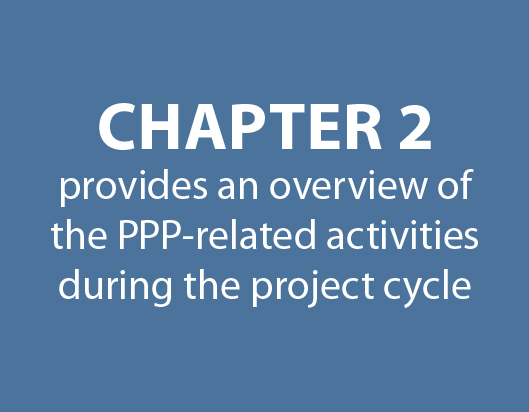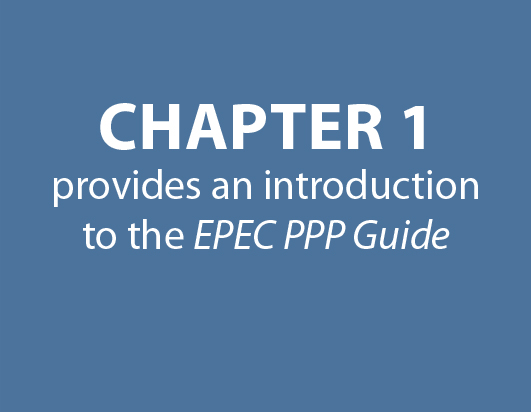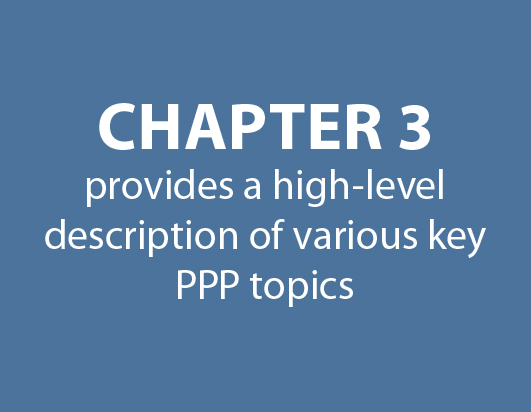Welcome
Welcome to the Guide to Public-Private Partnerships (EPEC PPP Guide). This guide is published by the European PPP Expertise Centre (EPEC), a Division of the European Investment Bank (EIB). This online version of the EPEC PPP Guide complements the PDF printable version (download) by offering a more interactive access to specific sections of the publication.
Structure
The EPEC PPP Guide consists of three chapters:
|
|
 |
Each chapter can be read independently from each other and are directly accessible from links at the bottom of each page.
Chapter 1: Welcome
Chapter 1 sets out the organisational structure of the document and identifies the component elements of the EPEC PPP Guide. Download the introduction
Chapter 2: Project cycle
Chapter 2 describes what the contracting authority should do and when, and is articulated over the four phases that constitute the project cycle. For each phase, Chapter 2 sets out a list of relevant activities, outlining their importance from the perspective of a contracting authority, and suggests a list of questions for consideration by the contracting authority before moving to the next phase. Chapter 2 contains direct links to Chapter 3, which offers further information on topics that help address those questions. These direct links can be immediately accessed by clicking on the key words in the ‘To find out more’ boxes. Download the project cycle phases
Chapter 3: List of PPP topics
Many of these topics arise repeatedly throughout the project cycle, and they are often associated with other topics (there is, for example, a close relationship between the topics of ‘Risk management’ and ‘PPP contracts’). Accordingly, instead of repeating the descriptions of these key topics at multiple points in Chapter 2, the various topics have been grouped together in Chapter 3. By this means, information regarding each key topic can be easily accessed, independently of the phase of the project. Chapter 3 also contains, for each topic, the references to the external resources that complement the information included for each topic. Download the topics
Aim of the guide
The EPEC PPP Guide provides a high-level framework to guide the public-private partnership (PPP) process, and it identifies other authoritative PPP guidance materials, available either online or in print publications, from a wide variety of sources.
The EPEC PPP Guide is primarily intended for public sector officials from European Union Member States who are involved in developing PPP policies or delivering PPP projects. It is recognised that users of the EPEC PPP Guide may find themselves at different stages of decision-making over the life of a PPP project. The following list provides some examples:
- A contracting authority has identified the need for a new project and is considering whether to use a PPP arrangement for its implementation. The contracting authority needs to compare the PPP option against other available project delivery strategies.
- A contracting authority wishes to implement a PPP arrangement but the public officials in charge of defining the delivery strategy have not previously been involved in or have little experience of PPP transactions, and would therefore like to understand what is involved.
- A PPP project is in the implementation phase and the contracting authority is not satisfied with the performance of the project company. The contracting authority wants to understand the options available to remedy the issue and ensure delivery of the service in accordance with the terms of the PPP contract.
- A government PPP unit is looking to update its PPP project preparation methodology in line with good practice.
Accordingly, the EPEC PPP Guide has been designed as a reference tool, so that different aspects and stages of the PPP process can be accessed as needed. Currently, there are numerous books and online guides that provide a view of processes and topics related to the preparation, procurement and implementation of PPPs. Throughout the EPEC PPP Guide, the user is directed to knowledge resources which address a topic in a particularly effective manner.
Background
For the purposes of the EPEC PPP Guide, a PPP arrangement has the following features:
- a long-term contract (the PPP contract) between a public contracting authority (the contracting authority) and a private sector company (the project company) for the delivery of a public service;
- the allocation of specified risks to the project company, typically with regard to designing, building, operating and financing the infrastructure asset used to deliver the public service;
- a focus on the specification of service outputs rather than inputs, taking account of the whole life-cycle implications for the infrastructure asset;
- the application of private financing (often involves a project finance loan) to underpin the risks transferred to the private sector; and
- performance-based payments to the project company, based on the level and quality of the public services delivered. The project company may be paid either by users through user fees (for example, motorway tolls); by the contracting authority (for example, availability payments or shadow tolls); or by a combination of both (for example, by having relatively low user fees combined with availability payments from the contracting authority).
The long-term contractual commitment between the contracting authority and the project company under a PPP arrangement means that many of the issues, risks and challenges faced over the economic life of the infrastructure asset and the delivery of the service need to be identified and addressed before the PPP contract is signed. Accordingly, PPP transactions require a high level of up-front preparation. Preparing and contracting PPP projects may require new skills and approaches for those government entities that are used to more conventional approaches to delivering public investment projects.
This EPEC PPP Guide is an update of the 2015 version of the EPEC Guide to Guidance knowledge product. In addition, it builds upon the EPEC PPP Project Preparation Status Tool, which was developed to assist contracting authorities in assessing the preparation status of a PPP at the point of the decision to launch a public procurement procedure. It is also informed by the other numerous guides on specific PPP topics previously published by EPEC.
When consulting the external resources cited in the EPEC PPP Guide, readers should keep in mind the following points:
- The EPEC PPP Guide does not provide an exhaustive list of publications on PPPs. The subject is vast and, given the constantly ongoing development of PPP activity worldwide, new practices emerge and existing practices change. In preparing the EPEC PPP Guide, an effort has been made to review and recommend the principal PPP guidance materials that are currently relevant and useful.
- Most of the sources referenced in the EPEC PPP Guide are in English, and typically come from English- speaking countries, or from international organisations that use English for their publications (such as the World Bank, the Global Infrastructure Hub and similar organisations). However, the EPEC PPP Guide also includes some references to PPP-relevant guidance materials in non-English-speaking European countries, such as France, the Netherlands, Poland and Greece. In certain instances, such guidance is also available in English, but it may not always be the latest version of the document. In the latter instances, the EPEC PPP Guide refers to the latest versions available, in both the original language and the translated edition.
- EPEC is not responsible for the content of external resources listed in this document.
Disclaimer
The EPEC PPP Guide should not override national guidance that may be available, especially where this reflects agreed national policies and procedures. Rather, this tool should be considered as a supplement to any such guidance, and a source of information on matters that might not be covered by the national materials.
The EPEC PPP Guide does not replace the need for a contracting authority to take professional advice on legal, technical, financial, environmental and other matters connected with PPP projects. It does, however, seek to assist contracting authorities in having a more productive dialogue with their advisors.


